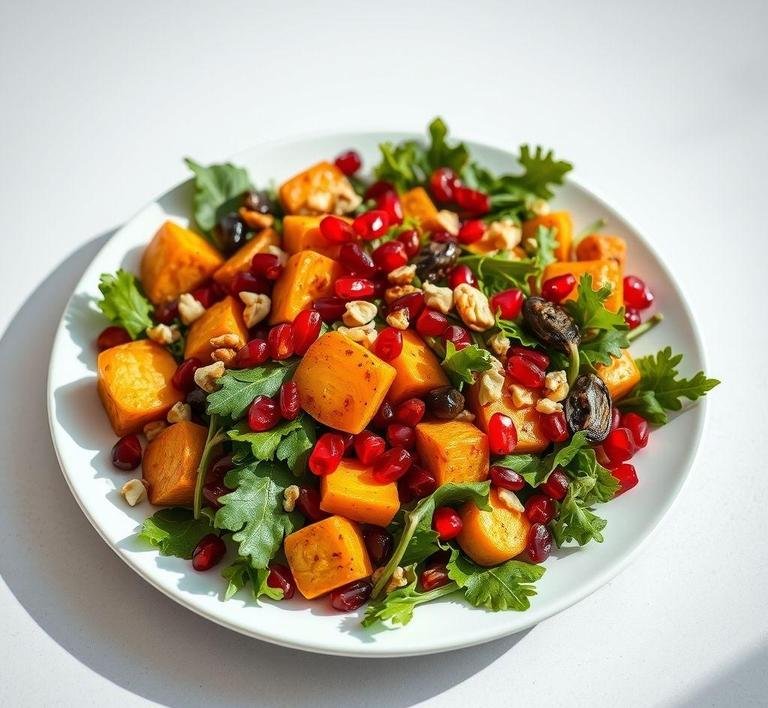Jamie Oliver’s Winter Salad isn’t your typical leafy green side dish. It’s a vibrant, hearty mix designed to celebrate the flavors of the colder months. Instead of relying on delicate spring veggies, this salad embraces root vegetables, nuts and robust greens that thrive in winter. It’s fresh yet filling, with a wonderful balance of textures and tastes-crisp, crunchy, sweet, tangy and nutty all at once.
Jamie’s idea is to create something that feels comforting but also fresh, perfect for when you want a salad that’s a bit more substantial. It’s great as a side but can also stand alone as a light meal. The best part? It’s seasonal and packed with nutrients that keep you energized and warm.
Jamie Oliver Winter Salad Recipe
Ingredients Needed
Here’s the magic behind the flavors:
- Root Vegetables: Think roasted carrots, parsnips or beets. These bring natural sweetness and earthiness.
- Cabbage or Kale: Sturdy winter greens add crunch and color.
- Pomegranate Seeds: They offer bursts of juicy sweetness and a festive look.
- Walnuts or Pecans: For crunch and a rich, buttery flavor.
- Feta or Goat Cheese: A tangy, creamy contrast to the crunchy veggies.
- Fresh Herbs: Parsley, mint or coriander for a fresh lift.
- Dressing: A simple mix of olive oil, lemon juice, maybe some mustard and honey for balance.
Jamie often encourages swapping ingredients based on what’s fresh and available which keeps this salad versatile and easy to customize.
Equipment Needed
You won’t need a fancy setup. Just the basics:
- Oven or Roasting Tray: To roast the root veggies until tender and caramelized.
- Mixing Bowl: To toss everything together.
- Knife and Cutting Board: For chopping veggies, herbs and nuts.
- Salad Spinner (Optional): Handy if you use leafy greens that need washing and drying.
- Measuring Spoons: For the dressing ingredients.
- Serving Dish: To present your vibrant creation.
That’s it-simple tools for a fresh, colorful salad.
How To Make Jamie Oliver’s Winter Salad
- Roast the Roots: Peel and chop your carrots, parsnips or beets into bite-sized pieces. Toss with olive oil, salt and pepper, then roast at 200°C (about 400°F) until golden and tender-usually 25 to 30 minutes.
- Prepare the Greens: While the roots roast, wash and roughly chop cabbage or kale. If the greens are tough, massage them lightly with a bit of olive oil and lemon juice to soften.
- Toast the Nuts: In a dry pan, lightly toast walnuts or pecans to bring out their flavor. Set aside to cool.
- Make the Dressing: Whisk olive oil, lemon juice, a touch of honey and a pinch of mustard together. Taste and adjust-this dressing should be bright and balanced.
- Assemble: In a large bowl, combine the roasted vegetables, greens, nuts and pomegranate seeds. Crumble the feta or goat cheese on top, pour over the dressing and gently toss everything together.
- Serve: This salad shines best fresh but can sit for a little while to let the flavors mingle.
What I Learnt

Making this salad taught me how winter produce can shine in unexpected ways. Roasting root veggies transforms them-what’s often overlooked becomes the star. The crunch from the nuts and the pop from the pomegranate seeds add texture that makes every bite exciting.
I also realized how important balance is-sweet, tangy, crunchy and creamy all in one bowl. It’s a lesson in layering flavors thoughtfully rather than piling on ingredients.
And lastly, this salad reminded me that salads aren’t just for summer. With the right ingredients, they can be cozy, warming and deeply satisfying even in the chilliest months.
Recipe Tweaks For Jamie Oliver’s Winter Salad
Jamie Oliver’s winter salad is already a winner-full of vibrant flavors and hearty textures. But tweaking it can take it to a whole new level. First, consider the dressing. Jamie usually keeps it simple but adding a splash of maple syrup or honey can give it a subtle sweetness that plays beautifully against the bitterness of winter greens like kale or radicchio.
Next, think about the crunch factor. Toasted nuts are a classic choice but why not experiment with different varieties? Hazelnuts bring warmth while pepitas add a smoky twist. Roasting them with a pinch of smoked paprika or cinnamon can give a subtle spicy warmth perfect for winter.
The fruit-jamie loves using seasonal fruit, like pomegranates or oranges. You can add a burst of tartness by throwing in some fresh cranberries or even stewed quince if you want to get fancy. It’s about balancing that deep, earthy vibe with bright, fresh hits.
Finally, don’t be afraid to swap or add veggies. Roasted butternut squash or caramelized beets complement the salad’s natural sweetness and add heft to keep it satisfying. A sprinkle of fresh herbs like parsley or tarragon at the end adds a pop of freshness to lighten things up.
Storage Tips For Leftovers
Winter salads can be tricky to store because they often involve delicate greens and fresh fruit. The key is to keep textures intact and avoid sogginess. First, separate any dressing from the salad if you know you won’t eat it right away. Store the salad and dressing in separate airtight containers. this keeps the leaves crisp and the dressing fresh.
If your salad has roasted veggies or nuts, store those separately too, if possible. Nuts especially lose their crunch quickly when exposed to moisture. Keep them in a small container or zip-lock bag. Roasted veggies can be reheated gently or eaten cold but keeping them apart avoids soggy salads.
When you’re ready to eat leftovers, toss the salad lightly with the dressing just before serving. If the greens have wilted a bit, try adding a handful of fresh leaves or crunchy elements like radishes or celery for that fresh crunch. Always store your salad in the fridge and try to consume it within 2 days to keep the flavors vibrant.
What To Eat With Jamie Oliver’s Winter Salad?
This winter salad is versatile and can play both a starring role or a sidekick at your meal table. If you want to keep it light, pair it with a hearty soup. think roasted tomato, butternut squash or even a rich mushroom broth. The warm soup contrasts nicely with the crisp, fresh textures of the salad.
For something more substantial, grilled or roasted meats work beautifully. A juicy roast chicken, herb-crusted lamb or even pan-seared salmon can bring out the earthy, nutty flavors in the salad. The warmth of the protein contrasts perfectly with the cool, fresh salad, making the meal balanced and satisfying.
Vegetarian options? Roasted chickpeas or a slice of crusty sourdough with whipped feta or hummus are fantastic. They add protein and texture, complementing the winter greens without overpowering them.
And if you’re in a casual mood, serve it alongside some roasted potatoes or sweet potato wedges. The caramelized edges of the potatoes add a cozy, filling element that works well with the freshness and bite of the salad.
FAQs
What Are The Main Ingredients In Jamie Oliver’s Winter Salad?
Jamie Oliver’s winter salad typically includes ingredients like seasonal greens, roasted root vegetables, nuts, seeds, and a zesty dressing.
Can I Make Jamie Oliver’s Winter Salad In Advance?
Yes, you can prepare the roasted veggies and dressing ahead of time, but it’s best to toss everything together just before serving to keep the salad fresh.
How Can I Make Jamie Oliver’s Winter Salad Vegan?
You can easily make it vegan by replacing any cheese or non-vegan dressings with plant-based alternatives like tahini or a balsamic vinaigrette.


